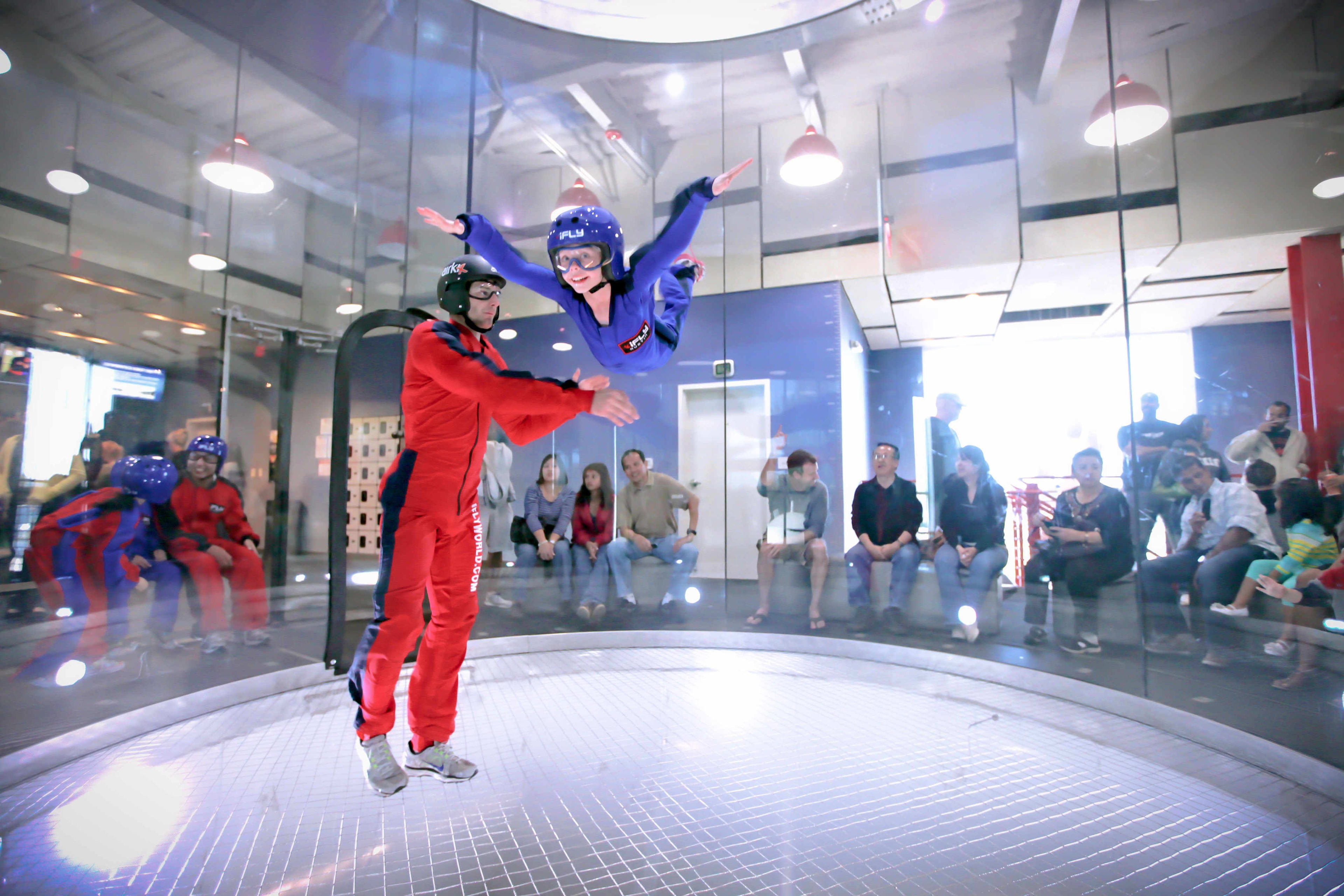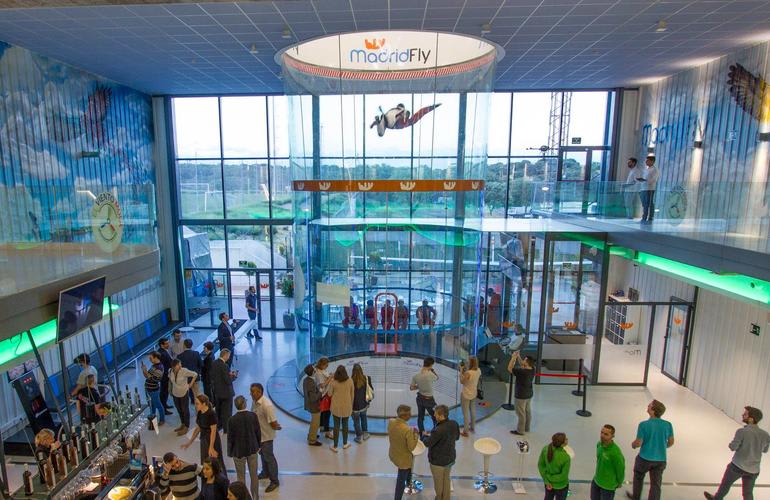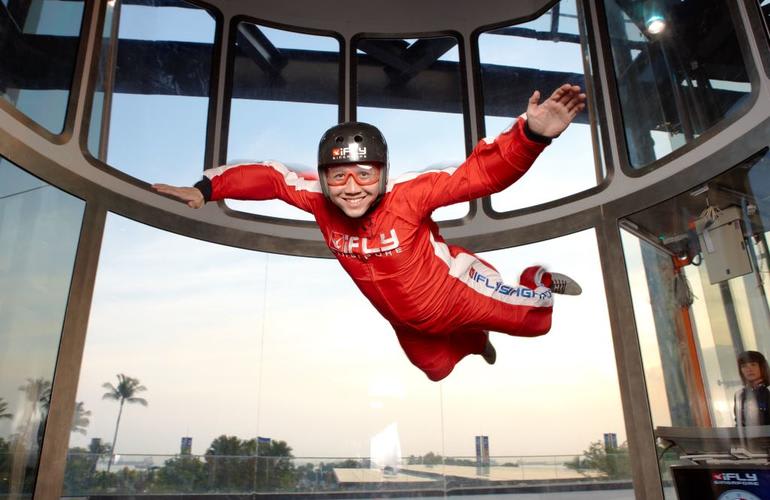Indoor Skydiving - What's It All About?

Looking for an original activity for a bachelor or bachelorette party? Want to try something a little different with your family or friends?
If the answer is yes, then it’s time to book a free-fall session in a wind tunnel!
Lucky for you skydive simulation isn’t exclusively reserved for paratroopers or those with no fear of heights, in recent years this activity has exploded in popularity and indoor skydive centers are popping up in many major cities in Europe, such as Madrid or Paris. Making this extreme sport, for the first time ever, accessible to all thrill seekers around the world!
Vertical wind tunnels, also known as indoor skydive simulators, are a great way to experience the feeling of weightlessness and can be experienced by absolutely everyone, but if you’re not sure it’s totally for you, this article explains in detail what it’s all about.
Unlike its extreme outdoor counterpart, an indoor free-fall simulation is not that physically demanding neither is it hard in a psychological sense, there is no risk of dizziness or fear of heights and planes to be taken into account. Simply, after a 20 minutes training brief to master the right movements and learn how to fly alone, you’ll enter a secure glass tube and let yourself be levitated in apparent weightlessness by the wind. Pretty easy and completely unique!
Depending on the tariff chosen, you can spend from 2 to 10 minutes in wind tunnel wonder, usually in about 40 second bursts. The likeness to an actual free-fall from an airplane is quite accurate, as this is approximately the same amount of time that would elapse before you would need to open your parachute.
We recommend you do this activity in a group and share the craziness and memorable moments with people you don’t mind looking a bit goofy in front of, because at at one point during the briefing you’ll need to climb up on a stool to adopt the free-fall position. It’s always a good laugh for everyone watching!

Another inclusive aspect about this form of skydiving is that its easily accessible for those with a disability, there’s minimal preparation needed to take part and there are specially trained instructors ready to support and guide people with reduced mobility, and, of course, the artificial wind is responsible for keeping you in the air.
The upward thrusting air has to be generated with phenomenal power to be able to reproduce the effects of a fall in the sky and thus keep you air-bound, so do not be too surprised if you find your cheeks and lips rippling in the wind! You’ll be given a mask to cover your eyes but if the wind in your nose is preventing you from breathing, then ask for a closed full-face helmet, or be guided through how to relax to and breathe in the air. Stay calm, take a breath and enjoy the moment, because it only lasts one minute per session before you find your feet back on solid ground, so every second counts!
If you feel comfortable, then the supervisor can offer you the chance to aerially climb to the top of the glass tube, it only costs an extra 9 euros and it’s more than worth it. Free fall in the wind tunnel is four times cheaper in price than a parachute jump, and lasts twice as long, so it is a good compromise to start with and far more accessible.
Free fall in the wind tunnel or from an airplane is a real sport. There are multiple disciplines in free fall like Freestyle, Freefly, Swooping … The best known probably being Relative Flight. The fan allows an athlete to train to expertly control their movements during the free fall. The restricted space of the tube forces the athletes to be precise and to control the extent of how far they travel and move. It’s an unmissable training tool for ensuring perfection during a parachute jump or in a competition.
Maybe you’ve seen the incredible video of Luke Aikins, who jumped without a parachute? Well if he managed to reach his target 7.5 kilometers down it’s all thanks to a perfect control during the free fall! No, you’ll not be able to reach his level by only practicing in the wind tunnel, we know that all sports require a tireless repetition of certain movements, but the indoor skydive is a simple solution to keep fit in the winter and fine tune skills!

Free fall Wind Tunnel Participation Conditions
Whether for sport or just for an outing with friends, there are still conditions. This activity remains in the sporting field and can present risks if not practiced appropriately.
Every indoor freefall structure has its own degree of rules of course, but the basics are always the same.
– Maximum weight for practice: usually around 110/120 pounds. Beyond that, you can always ask if the facility can adapt the power of the fan. You don’t want run any risks but it would be a shame not to fly!
– Minimum age: specific to each facility, but it’s good to know that young children are often admitted. At iFly, for example, children from 5 years old are welcome, they just need to be accompanied by their parents and the parents are required to attend the briefing. So don’t hesitate in booking an indoor skydive outing with your family!
– No recent injuries: if you have your arm in the cast … No. If you have dislocated your shoulder or removed a knee recently … No! If in doubt, talk to your doctor and, especially, mention it to your instructors!
– It should go without saying, but it will never be repeated enough: you can’t perform; under the influence. If you are under the influence of drugs or alcohol, you will be denied access to the blower! Inside the tube, you must be attentive to the instructions from your teacher and this means having a clear mind, as is the case in most sports.
– Activity not recommended for pregnant women. It’ll only take a few months before you can try it, so, in the meantime, take notes on the technique and, more importantly, take photos, lots of photos!
Comparisons to a Parachute Jump
Is the reason you have never jumped with a parachute because it scares you? Well, with the he simulator, you can put aside the fear of jumping from a flying plane and still experience the pleasure of a free-fall. The simulation is perfect, the wind created by a giant fan carries you and puts a grin on your face that spreads from ear to ear, just like during a real jump!
Learn the same techniques used during a real parachute jump, such as, how to position yourself correctly in the air to have maximum lift and avoid the stinging sensation generated from the speed. To be honest, one of the biggest differences is that when you look down, there is a net with a fan below and not rolling fields. The free fall technique doesn’t vary between a parachute jump and the indoor skydive, and the sensation of free falling is very similar whether you’re skydiving or wind-tunneling. In fact, the physical laws apply whatever happens and the floating sensation is quite comparable.
On the other hand, the panoramic landscape views and adrenaline rush you get during a fall fro; a plane can’t quite be replicated in the simulation, but still, the indoor skydive is a really unique and fun-filled experience!
Hopefully we have convinced you that this quirky activity is accessible and enjoyable by everyone – so all you need to now is find your nearest free-fall simulator and get flying!
